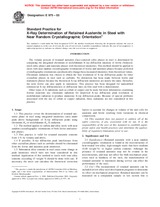Potřebujeme váš souhlas k využití jednotlivých dat, aby se vám mimo jiné mohly ukazovat informace týkající se vašich zájmů. Souhlas udělíte kliknutím na tlačítko „OK“.
ASTM E975-03
Standard Practice for X-Ray Determination of Retained Austenite in Steel with Near Random Crystallographic Orientation
Automaticky přeložený název:
Standardní praktiky pro X - Ray Stanovení zbytkového austenitu v oceli s Near Random Crystallographic Orientace
NORMA vydána dne 1.11.2003
Informace o normě:
Označení normy: ASTM E975-03
Poznámka: NEPLATNÁ
Datum vydání normy: 1.11.2003
Kód zboží: NS-48671
Počet stran: 7
Přibližná hmotnost: 21 g (0.05 liber)
Země: Americká technická norma
Kategorie: Technické normy ASTM
Anotace textu normy ASTM E975-03 :
Keywords:
austenite, crystallographic orientation, ferrite, martensite, retained austenite, X-ray diffraction, ICS Number Code 77.080.20 (Steels)
Doplňující informace
| Significance and Use |
|
Significance—Retained austenite with a near random crystallographic orientation is found in the microstructure of heat-treated low-alloy, high-strength steels that have medium (0.40 weight %) or higher carbon contents. Although the presence of retained austenite may not be evident in the microstructure, and may not affect the bulk mechanical properties such as hardness of the steel, the transformation of retained austenite to martensite during service can affect the performance of the steel. Use—The measurement of retained austenite can be included in low-alloy steel development programs to determine its effect on mechanical properties. Retained austenite can be measured on a companion sample or test section that is included in a heat-treated lot of steel as part of a quality control practice. The measurement of retained austenite in steels from service can be included in studies of material performance. |
| 1. Scope |
|
1.1 This practice covers the determination of retained austenite phase in steel using integrated intensities (area under peak above background) of X-ray diffraction peaks using chromium K or molybdenum K X-radiation. 1.2 The method applies to carbon and alloy steels with near random crystallographic orientations of both ferrite and austenite phases. 1.3 This practice is valid for retained austenite contents from 1 % by volume and above. 1.4 If possible, X-ray diffraction peak interference from other crystalline phases such as carbides should be eliminated from the ferrite and austenite peak intensities. 1.5 Substantial alloy contents in steel cause some change in peak intensities which have not been considered in this method. Application of this method to steels with total alloy contents exceeding 15 weight % should be done with care. If necessary, the users can calculate the theoretical correction factors to account for changes in volume of the unit cells for austenite and ferrite resulting from variations in chemical composition. 1.6 This standard does not purport to address all of the safety concerns, if any, associated with its use. It is the responsibility of the user of this standard to establish appropriate safety and health practices and determine the applicability of regulatory limitations prior to use. |
Odebírejte informace o nově vydaných normách ZDARMA:
Chcete pravidelně odebírat informace o nově vycházejících normách z celého světa a to zcela zdarma?
Přihlašte se k odběru. Vše je velice jednoduché a absolutně ZDARMA.
Na výběr máte vydavatele z celého světa.




 Cookies
Cookies
